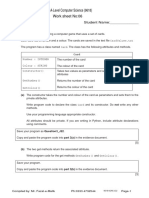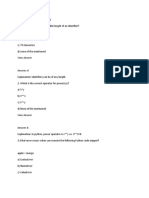Fundamentals of Programming: Lab Practical Week 1 Objective
Uploaded by
Ali KhanFundamentals of Programming: Lab Practical Week 1 Objective
Uploaded by
Ali KhanFundamentals of Programming Lab Week 1 Page 1
Fundamentals of Programming
Lab Practical week 1
Objective:
The install IDE and compile your first program.
Download & Install:
Download software from following link
https://drive.google.com/open?id=1KkZiWsQulJRvppCIVP7i4-YXoWwPyhX7
Right click the file and click Run as administrator.
Select English language, agree the terms, click next and install the software and upon
completion, click Run DevC++ and click finish.
First time Run:
Select English(Original) and click next
Click next leaving the options as it is, and press ok.
Now you are ready to write your first C++ program
First Program:
“Hello World”
Click on the File tab in top left corner and create new Source file.
Write the following code (always keep in mind that C++ is case-sensitive language, for
example if you typed Include instead of include the compiler will report error)
//HelloWorld.cpp
/* This is my first C++ program.
*/
#include <iostream>
using namespace std;
int main()
{
cout<<"Hello World";
}// End of Program
When you are done with code writing, compile and run the file by pressing F11.
City University of Sciences and Technology Peshawar Furqan Nasir
Fundamentals of Programming Lab Week 1 Page 2
A window will pop up, asking you to select place to save the file and give it name,
remember give name keeping in mind the working of program and add extension .cpp at
the end of program name. Click save and you will see the following
Exercise:
1. Try printing the following strings, what do they do?
1. "Hello \t World"
2. "Hello \n World"
2. Change the HelloWorld.cpp program so that it displays AssalaMu AlaiKum! Instead of
Hello World!
City University of Sciences and Technology Peshawar Furqan Nasir
Fundamentals of Programming Lab Week 1 Page 3
Arithematic Operators
Arithmetic operators are the symbols that represent arithmetic math operations.
Examples include + (addition operator), - (subtraction operator), * (multiplication
operator), / (division operator) and %(remainder operator).
Program:
Program:
City University of Sciences and Technology Peshawar Furqan Nasir
Fundamentals of Programming Lab Week 1 Page 4
Result:
For taking input from user, first we declare variable(int a;) and then following command
takes input from user
cin>>a;
so a will have the value given at console by user.
Exercise:
1. Make calculator performing addition, subtraction, multiplication, division and finding
remainder taking inputs from user.
2. Develop a temperature conversion program taking temperature in Fahrenheit and
converting it into Celsius.
Conversion Formula: Celsius= (Fahrenhrit - 32) *5/9
City University of Sciences and Technology Peshawar Furqan Nasir
Fundamentals of Programming Lab Week 1 Page 5
Some other operators
++ (Increment)
-- (Decrement)
+= (Increment Assignment)
-= (Decrement Assignment)
*= (Multiplication Assignment)
/= (Division Assignment)
%= (Remainder Assignment)
Increment and Decrement operators can be used in two ways, i.e.
i) Prefix
ii) Postfix
Program
City University of Sciences and Technology Peshawar Furqan Nasir
Fundamentals of Programming Lab Week 1 Page 6
Relational Operators
A relational operator compares two values. Comparisons involved in relation operators
can be
i) < Less than
ii) > Greater than
iii) == Equals to
iv) != Not equals
v) <= Less than or equals
vi) >= Greater than or equals
The result of comparison is either True or False. If a comparison provides 1, it
means True and if it provides 0, it means False.
Program:
City University of Sciences and Technology Peshawar Furqan Nasir
You might also like
- Work Sheet No. 1 STACK Implementation Using Array Name: - Reg - No.: - DateNo ratings yetWork Sheet No. 1 STACK Implementation Using Array Name: - Reg - No.: - Date12 pages
- Introduction To Computing Lab (CPEN-1214) : Department of Mechanical EngineeringNo ratings yetIntroduction To Computing Lab (CPEN-1214) : Department of Mechanical Engineering32 pages
- Homework #07 - Answers: Jatinder Uses Internet Banking. This Pseudocode Checks Her PINNo ratings yetHomework #07 - Answers: Jatinder Uses Internet Banking. This Pseudocode Checks Her PIN100 pages
- Grade X AKU-eb Practical Problems With Some Example SolutionsNo ratings yetGrade X AKU-eb Practical Problems With Some Example Solutions26 pages
- Lesson Plan - Introduction To C ProgramingNo ratings yetLesson Plan - Introduction To C Programing7 pages
- Lab Experiment No.02: Introduction To Computing (COMP-01102) Telecom 1 Semester100% (1)Lab Experiment No.02: Introduction To Computing (COMP-01102) Telecom 1 Semester5 pages
- Chapter One: Introduction To Computer ProgramsNo ratings yetChapter One: Introduction To Computer Programs12 pages
- Computer Science Paper 2 Final Revision Questions - 2017No ratings yetComputer Science Paper 2 Final Revision Questions - 20179 pages
- Chapter 3: Organization of Computer Systems: ObjectivesNo ratings yetChapter 3: Organization of Computer Systems: Objectives21 pages
- Python Programming PDF Myanmar PDF Files DownloadNo ratings yetPython Programming PDF Myanmar PDF Files Download6 pages
- Python Questions and Answers - Variable Names: AdvertisementNo ratings yetPython Questions and Answers - Variable Names: Advertisement10 pages
- Quiz 1 (CLO-1) : Fall 2017 CS-111 Computer FundamentalsNo ratings yetQuiz 1 (CLO-1) : Fall 2017 CS-111 Computer Fundamentals2 pages
- COSC - 3104 - Compiler Construction, 16-Weeks Plan Course Outline100% (1)COSC - 3104 - Compiler Construction, 16-Weeks Plan Course Outline6 pages
- Computer Pseudo Codes and Flow Charts AlgorithmNo ratings yetComputer Pseudo Codes and Flow Charts Algorithm20 pages
- O Level Computer Studies - Practice Questions For Cie Exams 2013100% (3)O Level Computer Studies - Practice Questions For Cie Exams 201341 pages
- Solution Manual For Assembly Language Programming and Organization of IBM PC PDFNo ratings yetSolution Manual For Assembly Language Programming and Organization of IBM PC PDF129 pages
- Assignment 2-2.1.2 Pseudocode and Flowcharts100% (1)Assignment 2-2.1.2 Pseudocode and Flowcharts3 pages
- Bahria University (Karachi Campus) : Midterm Examination - Spring Semester - 2020 (Computer Programming CSC-113)No ratings yetBahria University (Karachi Campus) : Midterm Examination - Spring Semester - 2020 (Computer Programming CSC-113)4 pages
- CU-2022 B.Sc. (Honours) Computer Science Semester-2 Paper-CC-3 QPNo ratings yetCU-2022 B.Sc. (Honours) Computer Science Semester-2 Paper-CC-3 QP2 pages
- Syntax: Syntax Error Refers To An Error in The Syntax of A SequenceNo ratings yetSyntax: Syntax Error Refers To An Error in The Syntax of A Sequence33 pages
- Propositional Logic: Instructor: Engr. Iqra SaleemNo ratings yetPropositional Logic: Instructor: Engr. Iqra Saleem14 pages
- Subhan Ullah Lecturer, Deptt of Computer Sciences, CUSIT: 1 Operating System Concepts (CSC-217) - Week 2, Lecture 3No ratings yetSubhan Ullah Lecturer, Deptt of Computer Sciences, CUSIT: 1 Operating System Concepts (CSC-217) - Week 2, Lecture 320 pages
- Fundamentals of Programming: Lab Practical Week 4No ratings yetFundamentals of Programming: Lab Practical Week 44 pages
- A Sampler of Confidentiality Clauses - 020510No ratings yetA Sampler of Confidentiality Clauses - 0205103 pages
- Assignment No 2 Name: Misbah Ur Rahman Reg Id: 12083 Section: ES Semester: 1 Course: BSSE Subject: Applied Physics Teacher Name: Qazi Haseeb YousufNo ratings yetAssignment No 2 Name: Misbah Ur Rahman Reg Id: 12083 Section: ES Semester: 1 Course: BSSE Subject: Applied Physics Teacher Name: Qazi Haseeb Yousuf10 pages
- 8e1e31de1 - Partition of Bengal 1905 Word FileNo ratings yet8e1e31de1 - Partition of Bengal 1905 Word File10 pages
- Powerbuilder Enterprise: Installation GuideNo ratings yetPowerbuilder Enterprise: Installation Guide42 pages
- Reading and Writing 1 Q: Skills For Success Unit 8 Student Book Answer Key50% (2)Reading and Writing 1 Q: Skills For Success Unit 8 Student Book Answer Key4 pages
- Church Fathers Papal Infallibility Erick YbarraNo ratings yetChurch Fathers Papal Infallibility Erick Ybarra29 pages
- The Secular Songs of John Blow: An EditionNo ratings yetThe Secular Songs of John Blow: An Edition5 pages
- Write A Pseudocode To Find The Largest of Two NumbersNo ratings yetWrite A Pseudocode To Find The Largest of Two Numbers36 pages
- Curriculum Vitae: Harsha B J E-Mail: Contact No: +91-8150028397No ratings yetCurriculum Vitae: Harsha B J E-Mail: Contact No: +91-81500283974 pages
- (Nov-2020-Updated) PassLeader 2020 CCNP 300-410 ENARSI Exam DumpsNo ratings yet(Nov-2020-Updated) PassLeader 2020 CCNP 300-410 ENARSI Exam Dumps7 pages
- Work Sheet No. 1 STACK Implementation Using Array Name: - Reg - No.: - DateWork Sheet No. 1 STACK Implementation Using Array Name: - Reg - No.: - Date
- Introduction To Computing Lab (CPEN-1214) : Department of Mechanical EngineeringIntroduction To Computing Lab (CPEN-1214) : Department of Mechanical Engineering
- Homework #07 - Answers: Jatinder Uses Internet Banking. This Pseudocode Checks Her PINHomework #07 - Answers: Jatinder Uses Internet Banking. This Pseudocode Checks Her PIN
- Grade X AKU-eb Practical Problems With Some Example SolutionsGrade X AKU-eb Practical Problems With Some Example Solutions
- Lab Experiment No.02: Introduction To Computing (COMP-01102) Telecom 1 SemesterLab Experiment No.02: Introduction To Computing (COMP-01102) Telecom 1 Semester
- Computer Science Paper 2 Final Revision Questions - 2017Computer Science Paper 2 Final Revision Questions - 2017
- Chapter 3: Organization of Computer Systems: ObjectivesChapter 3: Organization of Computer Systems: Objectives
- Python Questions and Answers - Variable Names: AdvertisementPython Questions and Answers - Variable Names: Advertisement
- Quiz 1 (CLO-1) : Fall 2017 CS-111 Computer FundamentalsQuiz 1 (CLO-1) : Fall 2017 CS-111 Computer Fundamentals
- COSC - 3104 - Compiler Construction, 16-Weeks Plan Course OutlineCOSC - 3104 - Compiler Construction, 16-Weeks Plan Course Outline
- O Level Computer Studies - Practice Questions For Cie Exams 2013O Level Computer Studies - Practice Questions For Cie Exams 2013
- Solution Manual For Assembly Language Programming and Organization of IBM PC PDFSolution Manual For Assembly Language Programming and Organization of IBM PC PDF
- Bahria University (Karachi Campus) : Midterm Examination - Spring Semester - 2020 (Computer Programming CSC-113)Bahria University (Karachi Campus) : Midterm Examination - Spring Semester - 2020 (Computer Programming CSC-113)
- CU-2022 B.Sc. (Honours) Computer Science Semester-2 Paper-CC-3 QPCU-2022 B.Sc. (Honours) Computer Science Semester-2 Paper-CC-3 QP
- Syntax: Syntax Error Refers To An Error in The Syntax of A SequenceSyntax: Syntax Error Refers To An Error in The Syntax of A Sequence
- Propositional Logic: Instructor: Engr. Iqra SaleemPropositional Logic: Instructor: Engr. Iqra Saleem
- Subhan Ullah Lecturer, Deptt of Computer Sciences, CUSIT: 1 Operating System Concepts (CSC-217) - Week 2, Lecture 3Subhan Ullah Lecturer, Deptt of Computer Sciences, CUSIT: 1 Operating System Concepts (CSC-217) - Week 2, Lecture 3
- Assignment No 2 Name: Misbah Ur Rahman Reg Id: 12083 Section: ES Semester: 1 Course: BSSE Subject: Applied Physics Teacher Name: Qazi Haseeb YousufAssignment No 2 Name: Misbah Ur Rahman Reg Id: 12083 Section: ES Semester: 1 Course: BSSE Subject: Applied Physics Teacher Name: Qazi Haseeb Yousuf
- Reading and Writing 1 Q: Skills For Success Unit 8 Student Book Answer KeyReading and Writing 1 Q: Skills For Success Unit 8 Student Book Answer Key
- Write A Pseudocode To Find The Largest of Two NumbersWrite A Pseudocode To Find The Largest of Two Numbers
- Curriculum Vitae: Harsha B J E-Mail: Contact No: +91-8150028397Curriculum Vitae: Harsha B J E-Mail: Contact No: +91-8150028397
- (Nov-2020-Updated) PassLeader 2020 CCNP 300-410 ENARSI Exam Dumps(Nov-2020-Updated) PassLeader 2020 CCNP 300-410 ENARSI Exam Dumps






































































































